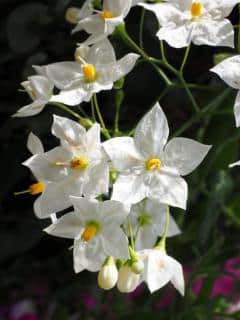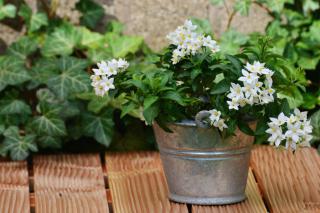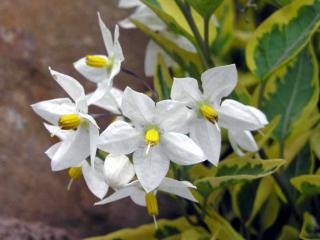

Potato vine (Solanum), also called jasmine nightshade for the resemblance they share, is a marvelous climbing vine.
A summary of Potato vine facts
Name – Solanum jasminoides
Family – Solanaceae or nightshade
Type – shrub, climbing vine
Height – 16 feet (5 m)
Exposure – full sun
Soil – well-drained
Foliage – semi-evergreen or evergreen – Flowering – July to November
Caring for it, from planting to pruning, is easy and its blooming is often spectacular.

It is possible to plant this nightshade in fall in mild-wintered areas or areas with a Mediterranean-type climate.
If a particular potato vine pleases you so much that you wish to propagate it, simply prepare cuttings or layer it in summer.
Overall an easy plant to care for, especially when well settled in. Solanum jasminoides is a climbing vine that doesn’t require much care.

Pruning isn’t really needed but you can still balance or reduce branches overall.
Indeed, potato vine can quickly become invasive if it has settled in well, and that’s why pruning it often can help control it.
Potato vine is vulnerable to freezing. It can resist low temperatures, but below 23°F (-5°C) or or 21°F (-6 °C), you’ll need to winterize it against the cold or it will die.
Upon purchasing your Potato vine, ask the salesperson how hardy that particular variety is. Some Solanum jasminoides varieties can cope with temperatures as low as 10°F (-12°C).
The first years, it is crucial to protect its roots with a thick layer of dried leaves, for example at least 8 to 12 inches (20 to 30 cm).
If the leaves have frozen and died, simply cut everything off in spring and your potato vine should grow anew if the roots were well protected.

It has the advantage of climbing when latticed and it offers very beautiful flowers that smell like jasmine, too.
Easy to care for and to grow, you can set it up at the foot of a wall, fence or even a tree that will serve as a surface for it to climb along.
Sometimes it turns invasive and overruns its allotted spot in the garden; if this is the case, make it a habit to cut it back every year.
Solanum jasminoides contains toxic compounds. These are irritating to the touch when handled and are even dangerous to children (and pets like cats and dogs) when ingested. Berries are where compounds are most present.
You can protect yourself by wearing light protection when pruning. Gloves and long-sleeved shirts are perfect.
Luckily, Potato vine pollen and fragrance don’t trigger allergies. You won’t have any asthma attacks purely by breathing in potato vine flowers.
Plant it near a spot where you like to relax or dine in your garden so that its fragrance can bring you happiness.
Read also
How do you propagate potato vine?
Hi Janette, there are two ways of doing so.
The first is layering: gently bend a portion of the vine down to the ground, or set up a pot of soil on a stool or something high. Bend the stem into a “U” shape and bury the bottom portion in the ground or pot, about 2-3 inches deep (5-8 cm). You can stabilize it with a metal hoop, or sticks in the ground that you tie to the stem to hold it in place. Make sure several leaf nodes are underground (where the leaves connect to the stem). Water regularly to keep the soil moist but not soggy. After a year, you’ll notice roots have grown out of the leaf nodes: at this point, you can cut the “ingoing” stem, and the rest of the plant will be able to survive! Layering is described in more detail here.
The other way of propagating is through cuttings. For cuttings, just snip half-foot portions of stems (15 cm) and stick them either in water or in moist potting mix, and keep moist. Roots will start forming and then you can plant them (more on cuttings here).
I have a potato vine that has a sticky white spots on the leaves and branches we have sprayed it with copper but it keeps re-accuring, please advise. thanks
Hi May, copper won’t do much: I think you might be dealing with scale insects. Copper is great against fungus, but scale insects (especially the mealybug variety) form whitish cocoons and the fungicide won’t hurt it. There many tips on how to deal with scale insects here.
A.m.done help me!! I have potato vines all along by back fence,all 6 years old,they are all starting to die!!.Underneath the green collage is brown and dead branches,I live in not Calif.,don’t know what’s gone wrong.
Dave
Hi Dave, there could be several things at play.
Freezing – If it got cold, as in, near freezing or colder, there’s a risk the vine froze and the air-borne parts are dying off. It’s normal, at least for certain varieties, but it also means that most of the vine will have to grow back from the stump of from whichever portion hasn’t died yet. It’s a fast grower, so nothing to worry about. Not much you can do except cover the roots with leaf mulch to make sure the portion that’s in the soil stays healthy.
Disease – If the season was particularly rainy maybe the soil stayed soggy for too long. There’s always the risk of a root rot fungus when soil is wet and temperatures drop. Treat with fermented weed tea.
Age – A bit surprising to have a whole row of these die so young, since they can also reach 15 or nearly 20 years of age… but sometimes in harsher climates than their native tropics, lifespans are shorter.
Poison – extremely unlikely, but here’s a way to treat a poisoned plant, although not always successful… There was a case of a poisoned shrub, where birds caused it to nearly die due to excessive pooping!
Gaspard, thank you for your reply, the vines have never had a problem with the cold, and our last rainy season was fine, could their be an insect problem? Just a year ago they were beautiful, I’m stumped.
Dave
It very well may be insects, but you’d need to send a picture over to make sure of this.
Hi! Does anyone know a way to vine these yourself so it promotes a hard wood at the bottom. Also ive read around thats these have a life span of about 6 years. Idk if to believe this.
Hi! Took a few days to answer, but well, late is better than never! I’m not sure where you got that information about the life span, I’ve seen potato vines that were over a decade old and doing fine. They turn woody at the base when they’re allowed to grow quite large, kind of like bonsai making: you need to let it grow dense and lush for the trunk to thicken accordingly. Afterwards, when it’s grown thick, you can cut it back and keep the trunk nice and wide. But if you always prune it so there aren’t many branches or vines running around, the trunk won’t need to grow thick and will stay rather thin (but it’ll turn woody eventually). So it’s more a technique of “let it grow and prune only when the trunk is thick enough”… which might not be compatible with every garden!
The potato vine seems to be just what I need, my only concern is the fragrance. I am allergic to jasmine, will this be the same?
Hi Larry! Yes, potato vine is a great choice because although it smells like jasmine, it doesn’t trigger airborne allergies. However, the plant itself contains toxic compounds (especially the berries). This just means you should be careful not to ingest it. Particularly vulnerable persons should also wear gloves when manipulating it.
Other options for wonderful, scented, allergy-free vines are clematis (like Clematis montana) and sweet pea. These fragrant flowers are known to not trigger allergies.
Hi! I’m in Zone 5. I just bought my first potato vine in August, off the clearance shelf at my local greenhouse, looking so pitiful I had to try to rescue it. I potted it because I knew it wouldn’t survive outside in my zone. It was improving outdoors, provided some new blooms and foliage. It never has shown much foliage. I wouldn’t call the growth “significant,” but it looked strong and relatively healthy, compared with when I bought it. It’s about 2 feet tall from the top of the soil to the top of the tallest branches. I have never really *pruned* it, just kept it tidy, snipping off the dead stuff it came with. About three weeks ago, just before the first hard freeze, I brought the plant indoors (in the same container it was in outside, with some Bonide Systemic Houseplant Insect Control added to the soil). I have large, south-ish-facing windows, and it gets some direct sun, but mostly indirect sunlight. It finished blooming in the past day or two, and is now looking pretty ragged again. The thickest stems feel a bit rubbery to the touch, if that makes sense …? A lot of the tiny new-growth branches browned up and died, and now I’m noticing brownish, even more sparse foliage. My pot does have a drainage hole, and the plant seemed happy in it outside. I’m wondering if indoor potato vines go dormant during the winter months? Would now be a good time for a significant pruning? Should I repot with indoor potting soil and take extra measures to further improve drainage? Any other ideas? I am determined to save this beautiful plant! Thanks!
Dear Jodi, thanks for providing such detailed context! First off, it’s quite normal that change from out- to indoors would give the plant some form of a shock, it would have actually been strange for it to keep on going as if nothing had happened.
Blooming is expected to stop in November, so that’s pretty much on. As for the rubbery stems, this vine stays flexible for the first few years of growth, it would only turn woody on older growth. However, if it’s outright mushy then you might be losing the plant to rot due to overwatering. If this happens, best salvage healthy parts and make cuttings, because recovering from root rot is virtually impossible.
Yes, potato vine does go dormant in winter, to answer your question. Perhaps having it indoors near windows is actually too warm and dry for it. It would be best to move it to a cool place that still gets plenty of light, because now that the blooming is over, the plant will want to focus more on roots.
Potato vine likes rather large pots, around 1 ½ feet (40-45 cm) and you can plant in such a large pot directly, no need to upsize incrementally. Great that you’ve provided proper drainage. Have you checked that water doesn’t accumulate at the bottom of the pot because of the saucer under it? 10 to 15 minutes after watering, if you still see water in the saucer, dump all the excess water out.
Pruning dead plant material off is possible in any season as long as you’re only cutting in the dead wood. If you want to snip some live bits off, best wait until spring: again, the dormant winter phase is when Solanum jasminoides focuses on underground growth, and having wounds to heal isn’t the best at this time.
So to sum it up, it feels to me like your potato vine might be shaken up due to moving to a place that is consistently hotter and drier than what it expected given the season, and trying to find a cooler place with light (as long as it doesn’t freeze) should let it have a restful dormant period.
I’m sure it’ll do great under your diligent care, Jodi!
My potato vine is showing more yellow leaves at the bottom. It is in a pot against a wall and has grown aggressively. It seems to absorb watering quickly. I water daily but it goes dry overnight. Should I water 2x daily? Is this the cause of the yellowing of leaves?
Hi Pat! First of all, one possibility for the yellowing of leaves might simply be fall: in colder areas, your potato vine would lose its leaves. But I’d probably associate the yellowing of your solanum potato vine leaves in this case to water stress because:
* It’s growing in a pot. Pot-grown plants notoriously need a lot more water. This is even more true of terra cotta pots where water evaporates along the side of the pot. If you’ve got a terra cotta pot, you’ll help the pot retail a little water by rolling any type of plastic material around it, to cut wind off around the pot and lock moisture in. Or, you could lower the pot below ground level with the pot-in-pot technique, that would also cover that problem.
* It’s in full sun. That’s good because the plant needs that.
* It’s against a wall. That doubles the amount of heat and reflected light it gets, and shields off disturbing winds. It’s not a bad thing.
* You seem to practice watering in the morning. Much of the water given in the morning will evaporate before the plant even gets it.
So it’s quite normal that a), your plant grows stunningly lush and b) having reached these limitations, it starts feeling water stress.
What to do:
* Mulch the pot with shredded dried leaves, wood chips or cocoa hulls, anything to add a top layer of water-retaining organic material.
* Try watering in the evening. Your plant should soak up all the water overnight and should be able to cope with the entire next day.
* If you’re so inclined, try using hydrogel water crystals in your plant soil.
* If after a few days it doesn’t seem to help, you’ll have to either choose to trim it back to lessen water demand, transplant it to the ground in another spot, pot it in a larger container for a larger water reserve, find a way to water more continuously with a bottle drip…
* or simply, as you wondered, water twice daily!
Just ensure the water drains well, because stopping up the hole under the pot to just “keep the water in” would only work the first few days: as soon as water starts accumulating, root rot might occur.
Hope this helps!
Thank you Gaspard for all your help & information
As Summer is approaching & the leaves have stayed green, I have decided to keep it in full sun, where it is & hope by winter it is much more established. If not, I will purchase a new plant…
Kind regards
Sue
My potatoe plant climber leaves go yellow then fall off, it has only one stem which has wound its way around the trellis
Please help, it has been in for over a year.
Thanks kindly
Sue
Dear Sue, I’d love to help out, but I would need a bit more information, if you can share it:
* Where is your plant growing – in a house, a lean-in or outside, is it potted or growing in the ground? Do you live near the sea, in what country?
* Are the leaves falling off from bottom to top, or from top to bottom?
Possibilities range from simple lack of nutrients (fertilize with mostly anything, the plant isn’t picky) to fungal infections, which might require more care (repotting to ensure clean soil and better drainage, especially).